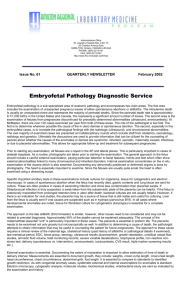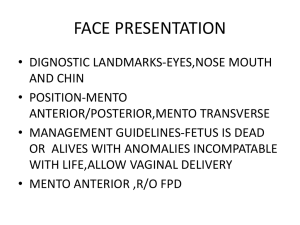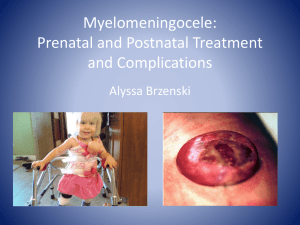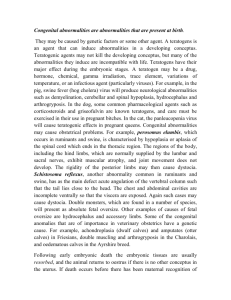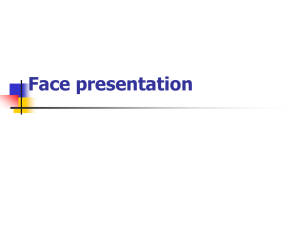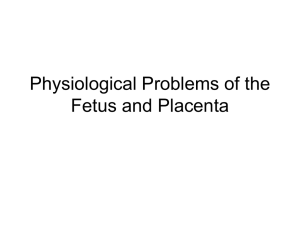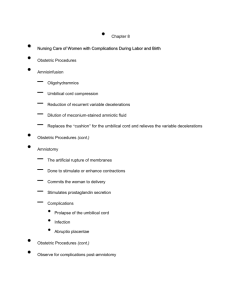File
advertisement
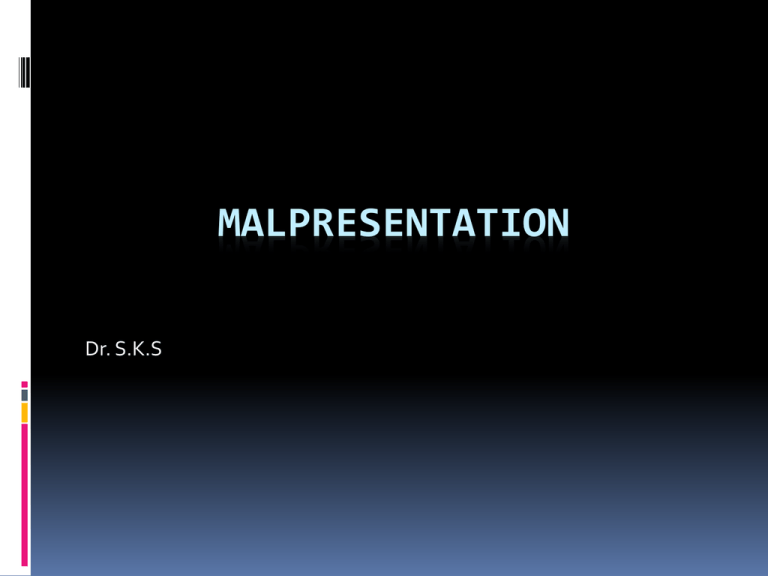
MALPRESENTATION Dr. S.K.S Definition:- The face of the fetus comes in the birth canal, when the head lies in the attitude of complete extension. Face presentation comprises of mouth with alveolar margins, nose, eyes, mentum and malar eminences. Position Left mento-anterior- commonest Right mento-anterior Left mento-posterior Right mento-posterior Incidence: 0.2% Mechanics of presentation: Characterized by extreme extension of the fetal head so the face (rather than the skull) presents to the birth canal Aetiology Any factor that favours extension such as fetal goitre, anencephaly High maternal parity Diagnosis Abdominal examination :Inspection :-there is no visible bulging of the flank, due to “S” shaped fetal spine. Palpation :- the diagnostic features in mento anterior and mento posterior are as follows:- Mento anterior Mento posterior Lateral grip 1. Fetal limbs are felt anteriorly. 2. Back is on the flank & is difficult to palpate. 3. The chest is thrown anteriorly against the uterine wall & is often mistaken for back. 1. Back is felt to the front and better palpated only towards the podalic pole because of extension of spine. Pelvic grip 1. Head seems big & not 1. Same engaged. 2. Same 2. Sinciput is to the side 3. The groove is towards the back lies. prominent. 3. Groove between the head and back is not so prominent. auscultation 1. FHS is distinctly audible anteriorly through the chest wall of the fetus. 1. FHS is not so distinct and is audible on the flank. Vaginal examination: Generally diagnosed on vaginal examination in labour The diagnostic features are palpating the mouth with hard alveolar margins, nose, malar eminences, supraorbital ridges and mentum. May be confused with breech presentation REMEMBER anus has sphincter tone & meconium stained, the mouth has sucking reflex. anus is in line with the ischial tuberosities; mouth forms a traingle with the malar prominences Investigation :USG to conform diagnosis and exclude fetal abnormalities. Management First stage : face presentation is conformed by abdominal and vaginal examination. Fetal size, malformation and pelvis are assessed. Partograph should be maintained. Bed rest. Maintain proper nutrition. Sedation if necessary. Second stage:Face presentation . Mento-anterior Mento-posterior 90% case normal spontaneous vaginal (face to pubis) delivery with liberal episiotomy If delay forceps delivery LSCS Dead fetus Craniotomy Third stage:- Active management. Complications:Maternal :Prolonged labour High operative interference. Fetus:1. cong. Malformation. 2. Hypoxia 3. Operative delivery 4. Laryngeal oedema. Cause of delayed engagement in face presentation:1. long diameter i.e. sub mento-vertical. 2. No moulding. 3. Weak uterine contraction. Definition:- brow or forehead presents when fetal head lies midway between full flexion and full extension(deflexion head). Incidence: 1:1400 Position:- Mento - anterior brow Mento –posterior brow BROW PRESENTATION Mechanics of presentation: head is extended such that attitude is halfway between flexion (vertex) and hyperextension (face) usually transitional- when the head is in the process of converting from a vertex to a face or vice versa presenting part is between the facial orbits and anterior fontanelle Diagnosis Abdominal examination:- Finding are same as face presentation except sinciput and the groove between it and back are less prominent. Vaginal examination: anterior fontanelle supra-orbital ridges eyes MANGEMENT IN LABOUR Initially expectant; 50-75% will either flex to a vertex, or extend to a face with contractions from behind meeting soft tissue and bony resistance below and will therefore deliver vaginally High incidence of prolonged labour and dysfunctional labour Persistent brow the diameter is undeliverable vaginally deliver by caesarean section

